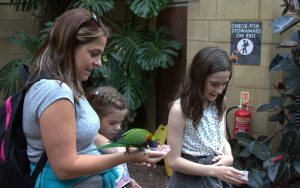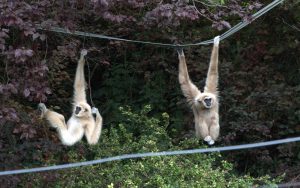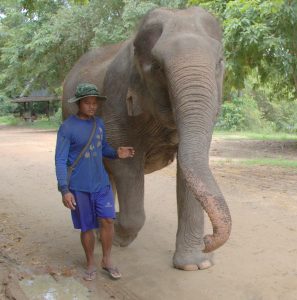
I’ve recently been to an animal sanctuary in Thailand and a family outing to Dudley Zoo. Comparing the two experiences has been fascinating and once more made me ask what zoos are for.
The Sanctuary
The Wildlife Friends Foundation Thailand (WFFT) lives up to its name as an animal sanctuary. WFFT aims to rescue and rehabilitate the animals as well as educate and campaign for better animal welfare.
Each animal in the sanctuary has its own story – usually very sad and disturbing. Elephants removed from brutal trekking camps, bears and monkeys rescued from the illegal pet trade. The list is long. (Read some of these moving stories on the WFFT website and Facebook pages)

Where possible the animals are returned to the wild, if they have recovered to a point where they can survive. Those that do not reach that stage, or are not endemic to the local wilds (such as Orang Utans), stay in the sanctuary. Yes, they are behind bars, but if they weren’t at the sanctuary they would have continued to suffer or even not survived.
We watched the vast majority of the animals from a safe distance but were allowed to get close to one elephant. We washed her, took her for a walk and fed her. Some criticise the washing of elephants and certainly swimming with them is a no-no, but this female was unable to socialise with the other elephants (who did have access to their own bathing pools), so for her this seemed like a good solution.
 More people are getting the message that swimming with elephants or riding them is wrong, as it involves ‘breaking’ young elephants to get then to cooperate. During the trip to the zoo, when my 13 year old great niece and I discussed this, she was surprised that riding elephants should be avoided. She is a keen horse rider and quite understandably could not see the difference. It is a complex message to get across.
More people are getting the message that swimming with elephants or riding them is wrong, as it involves ‘breaking’ young elephants to get then to cooperate. During the trip to the zoo, when my 13 year old great niece and I discussed this, she was surprised that riding elephants should be avoided. She is a keen horse rider and quite understandably could not see the difference. It is a complex message to get across.
Such education was at the heart of our day at WFFT, thanks to the volunteers who spent time with us. The volunteers come from all over the world; many are gap year students. Had that opportunity existed when I was a student I’d have jumped at the chance. Volunteering isn’t cheap, but it is for an excellent cause.
Not all sanctuaries live up to their name, but from what I saw during our day, WFFT and its volunteers were doing a great job. It was both highly inspirational and informative.
Going to the zoo
As a child I went to Dudley Zoo for my birthday treat nearly everyyear. This year I went again, with my sister, niece and two great nieces, the younger of whom was celebrating her 8th birthday. My last visit was decades ago, so I was interested to see how it would compare.
We started with features where contact with the animals is allowed. As most of the zoo’s visitors were young children this was a popular pastime. In the Farm Area we were able to touch giant rabbits, goats, geese and other familiar farmyard friends. In the bird house, lorikeets landed on our heads to lap up the pots of nectar we had bought to lure them. In Lemur Wood, although touching the delightful beings was strictly forbidden, we could get very close to them. All excellent opportunities for endless selfies.
We then moved on to see the bigger, wilder animals (lions, tigers and giraffes) many monkeys, meerkats and different birds. I was pleased to see that they are in much bigger enclosures than the cages I recall from my childhood. Dudley Zoo has come a long way since then, and further upgrades are planned. Even so, some cages still felt far too small and even the roomier enclosures are a fraction of what an animal would have in the wild.
So, do we need zoos?
Dudley Zoo, like many others, supports established welfare standards and continues to improve. But even if zoos meet the strictest standards, the question remains, do we need them?
Zoos provide an opportunity to see animals up close which we would otherwise never see. They are educational in this general sense, plus Dudley Zoo has a specific schools’ programme. It was exciting as a child seeing these exotic animals, but as an adult I couldn’t justify their captivity on these grounds alone.

There are other ways to learn about, and experience, wildlife. I’m lucky enough to have seen many animals in the wild (do check out my previous posts) and these have been fabulous experiences. However, these trips do cost money and it isn’t great for the carbon footprint if everyone flies thousands of miles to view wild animals.
Alternatively, we can stay at home and see them on TV. There is now fantastic footage available, usually with wonderful commentaries by David Attenborough. The latest viewing option, available at the recently opened Dubai Virtual Reality Zoo, utilises CGI and virtual reality technology to give a real sense of being with the animals. More virtual reality animal experiences will no doubt follow and I look forward to visiting one.

Beyond education, zoos justify their existence on the grounds of their conservation efforts. Many zoos, including Dudley Zoo, are involved in cooperative breeding programmes and other initiatives aimed at saving endangered species. Such work is clearly good, urgent even, for once an animal is extinct it is gone for ever. But as the Born Free Foundation points out, these efforts actually save very few animals compared with the millions in captivity. Our long- term aim should be to preserve species in their natural environment.
Entertainment v Conservation
Despite their conservation work, zoos remain heavily criticised. My day at Dudley Zoo helped me see why. It’s all about image and emphasis. As far as I could tell the many younger children visiting the zoo that day were excited to see the animals. Perhaps that generates a later interest in welfare and conservation; my trips to the zoo certainly did that for me. But I also noticed that the younger visitors were equally excited to go on the swings, roundabouts and many other pieces of playground equipment dotted about the place. Or have an ice cream while listening to the resident clown. The emphasis was on their entertainment. All great fun but very far from the serious approach of the animal sanctuary.

Our trip ended at the Zoo Gift Shop. It was full of toys and games, not a single book about wildlife or the zoo in sight. If a zoo justifies its existence by being all about conservation, surely it should communicate a little more on that subject to an adult audience? Yes, there was a very small exhibition about endangered species in the castle ruins, plus a few posters with links to online sources of information. But that was all. The absence of a single serious book spoke volumes.
Both trips were fascinating in their own way. It was much harder seeing the caged animals in the zoo than in the sanctuary. The sanctuary animals were rescues and that made all the difference. Zoo inmates may be part of a breeding programme, or other valuable research, but that’s a very different starting point. I was pleased to see the progress the zoo has made and welcome its conservation efforts. But that commitment to conservation should always come before entertainment, however lucrative the latter might be.

Links
www.facebook.com/WildlifeFriendsFoundation/

